
Goats in the Sailor's Diet: 1 2 3 4 Next>>
Goats in Sailor's Diets During the Golden Age of Piracy, Page 1
Goats as Food
"[May 28, 1702] There presently came off to us several canoes, with green trade. This Island [Saddle Island] is high land and very woody and pleasant, and affords good cattle, but small; plenty of goats and fowl, very cheap; but no sheep or hogs". (Francis Rogers, from Bruce S. Ingram's book Three Sea Journals of stuart times, 1936, p. 157)
Goats appear as food in nearly every seaman's journal from this period in history. When sailors set out from a port, if they could buy goats to take along as a source of fresh meat, it made for fresher fare than the casks of salted beef and pork that they would soon be restricted to on a
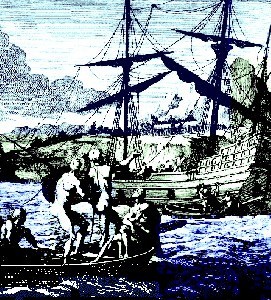
Natives Trading with Ships,
From Versameling der
Gedenk-Waardigste zee en Land-Reysen na
Oost en West-Indien, vol 15, p. 52
long voyage. As Rogers suggests, people in port knew this and would sometimes bring the food to the the ship in order to sell them to the sailors.
Upon arriving in Cadiz, Spain, Jean-Baptiste Labat explained that the "fishermen and other people who always come alongside a ship when she arrives in port did not fail on this occasion to offer us goods for sale, for the Spaniards suppose that any vessel coming from a long voyage must be short of everything."1 It is here we also learn of the practice of keeping cattle on board when Labat's ship disappoints the merchants.
These men were therefore surprised when they saw our pens of full of chickens, pigs, sheep and goats that there was sufficient live stock on board for a return voyage to America. It is quite true that every ship is not always so well provisioned as we were, but M. Maureller, his niece and myself brought so many provisions and animals, etc., on board that we were obliged to send a quantity of poultry ashore before we sailed as there was no room for them, and it was not surprising that we had so many left when we arrived, although we frequently entertained the officers and passengers of the other ships on board our vessel during this voyage.2
The importance of meat to the sailor in his diet is difficult to overstate. After pirate captain Bartholomew Roberts men had been at sea for an extended period without provisions, they first sought water. Charles Johnson reports that "they had no sooner quenched their
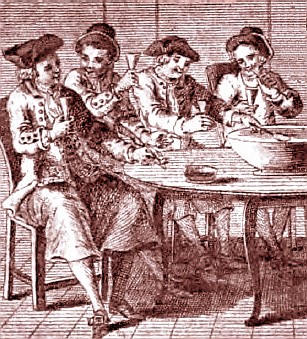
The British Sailors Loyal Toast, Taken from The British
Tar
in
Fact and Fiction, p. 136 (1738)
Thirst, but they had forgot the Miracle [of finding water], till Scarcity of Provisions awakened their
Senses, and bid them guard against starving; their allowance was very small, and yet they would profanely say, That Providence which had gave them Drink would, no doubt bring them Meat also if they would use but an honest Endeavour."3
This is not to say that they ate nothing but meat, but it was the victual of choice. When talking of food, many period journalists specifically mention 'meat and drink' as readily as we would talk of food and drink. Chaplain Henry Teonge rather tartly notes that the sailors threw the salt beef overboard "for the meat was so bad that they chose rather to eat bread dry than to eat that meat. That was much to our Purser’s discredit."4 The other foodstuffs aboard (and there would have been several dry goods) don't even merit a mention.
Beef and pork would have been the preferred meats. Still, goats were better than no meat, so when they were to be had, the sailors ate them.
Perhaps the most fascinating thing about goats as food is their ubiquitousness in the seaman's world. With that in mind, let's take a tour of the sailor's world with some of the journal-writers from this era.
1 Pere Jean-Baptiste Labat, The Memoirs of Pére Labat 1693-1705, p. 262; 2 Labat, ibid.; 3 Captain Charles Johnson, A general history of the pirates, 3rd Edition, p. 242; 4 Henry Teonge, The Diary of Henry Teonge, Chaplain on Board H.M.’s Ships Assistance, Bristol, and Royal Oak, 1675-1679, p. 138;
Goats as Food: Africa
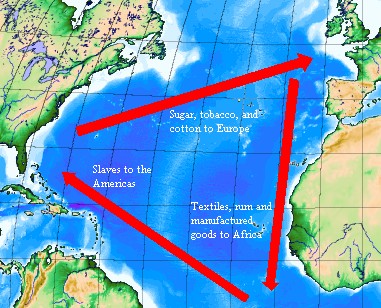
Triangle Trade Route by Simon P. from a Map by John Monnpoly
The western coast of Africa, particularly around Guinea, was one vertex of the important slave trade triangle. While in Santiago in the Cape Verde Islands off the west coast of Africa, slave trading captain Nathaniel Uring reported that the island provided "great Numbers of black Cattle, Goats, Hogs and Fowls, and
the Sea is well stored with Fish."1 Requesting 'live Cattle', the natives "brought down Droves of several Kinds, of which we furnish’d our selves with as many as we had Occasion for, at easy Rates; we bought a large Hog for Two Shillings and Six-pence, and Goats at the same Rate; large Fowls for less than Six-pence a-piece... [however] the Cattle are seldom fat."2
John Covel tells us that when they went ashore to get water in Tunis, Tunisia, there appeared "many country people with Eggs, Hens, Sheep, Goats, Bullocks, milk, Pompions [Pumpkins], Fish, Pigeons, citrons, Dates, Oranges, Lemons,and Limes (which are a sort of hedge or crab Lemmons), with whose juice our Seamen make their punch. ... Every ship stored themselves from hence with what they wanted of sea provisions."3
Goats as Food: Africa - St. Thome & Principe, Guinea
Charles Johnson takes a break in the middle of his history of pirate captain Howell Davis to provide a description of the islands he calls "St. Thome, Del Principle and Annobono."4 These islands off the coast of Africa were apparently well known to triangle traders during this time; Johnson explains, "Most of the Ships from Guiney, of their own Nation, and frequently those of ours, call at one or the other of these Islands to recruit with fresh Provisions, and take in Water,
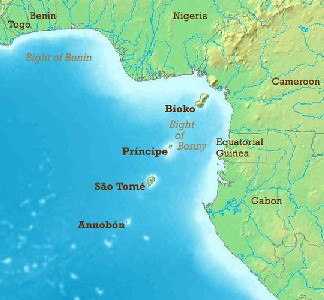
A Modern Map of Principe, Sao Tome & Annobon
which on the Coast are not so good, nor so conveniently to come by"5. While he finds the beef on St. Thome somewhat lacking, he notes that "the Goats, Hogs and Fowls [are] very good... [the people of the islands] come to us in Way of bartering, very cheap: A good Hog for an old Cutlash, a fat Fowl for a Span of Brasil Tobacco... But with Money you give eight Dollars per Head for Cattle; three Dollars for a Goat, six Dollars for a grown Hog, a Testune and a Half for a Fowl..."6
Johnson describes another of the islands, Principe, as "a pleasant Intermixture of Hill and Valley; the Hills spread with Palms, Coco-Nuts, and Cotton-Trees, with Numbers of Monkeys and Parrots among them; the Valleys with fruitful Plantations of Yamms, Kulalu, Papas, Variety of Sallating [salading], Ananas, or Pine-Apples, Guavas, Plantanes, Bonanas, Manyocos, and Indian Corn, with Fowls, Guinea Hens, Muscovy Ducks, Goats, Hogs, Turkies, and wild Beefs, with each a little Village of Negroes, who, under the Direction of their several Masters, manage the Cultivation, and exchange or sell them for Money, much after the same Rates with the People of St. Thome."7 Woodes Rogers agrees with Johnson's assessment, finding that in St. Antonio on Principle Island they had "plenty of Cattel, Goats, Hogs, Fowls, Melons, Potatoes, Limes, ordinary Brandy, Tobacco, Indian Corn, etc."8
Goats as Food: Africa - Cape Verde
Also off the coast of Guinea are
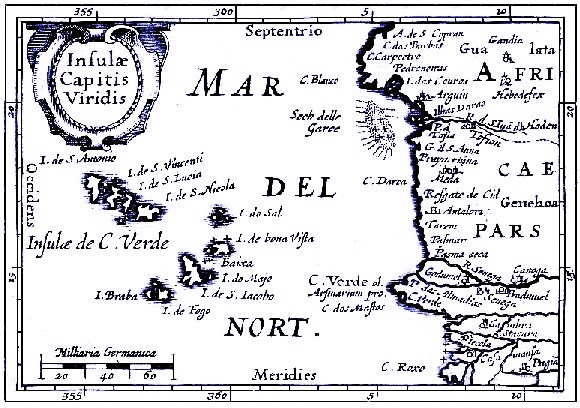
Map of the Cape Verde Islands, National Library of France (1598)
10 small Islands that today form the nation of Cape Verde. We would have no record of them from the period under consideration but for the efforts of Captain George Roberts. In 1721, following his capture by Edward Low's pirates, Roberts was set adrift in his sloop with two boys, no provisions and almost no other supplies. He made a rather trying journey to St. John's [today called Brava] in the Cape Verde Islands where his vessel eventually wrecked. He found himself stuck in an open area by the bay where his craft wrecked with no way to get to the main village near him. Fortunately the natives on St. John took great pity on him.
Roberts became very ill with 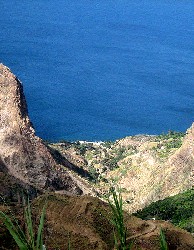
Photographer: Iwoibern
A Goat's View of St. John - The
valley of Fajã de Água, Brava
an ague [fever] which continued even after his rescue. It "brought me so low that I was uncapable of any thing except writing; which, by the perswasion of friends, I undertook, and, by the Blessing of God upon the Medicines administred, I recovered my Health... [but still] resolv'd to compleat it, and found the doing of it much more tedious and painful at first I imagin'd it would be"9 Thus did Roberts experience the joy of writers everywhere thanks to his illness. (But I digress.)
Roberts reveals much of interest about goats and their role in these islands during the course of his narrative.
Amongst the others on the island, Roberts finds a former Welsh-born man, who tells him there was at one time on St. John's "Store of Very good Fish about the Island; and that there had been considerable Numbers of good wild Goats; but that most of them had been destroy'd [during a famine in these islands]"10. Droughts are apparently common in the Cape Verde islands. As a result, according to one website, "Famine and starvation have ravaged the Cape Verde Islands numerous times over the last five centuries."11 The goats were still around in the mountains, as Roberts discovers when he tries to take the rocky path up to the village and the goats start knocking rocks upon him during their wanderings further up the the mountainside.12
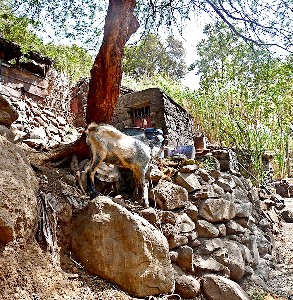
Photographer: Ji-Elle
A Goat guarding a Santiago, Cape Verde Sugar Distillery
The sympathetic natives frequently brought Roberts goat to eat from the village, courtesy of the islands 'governor' and other local dignitaries. The island governor at this time had the unusual status of being the ward of the wild goats. Roberts reveals that "the Privilege of killing the wild Goats is intirely the Governor's, without whose Leave, no one dare hunt, and this was a law made by the Portuguese when they first peopled these Islands, and put a Breed of Cattle on them, to prevent the Breed from being utterly destroy'd."13
It is interesting that the island is almost entirely peopled by Africans who were sent there to cultivate the islands for the Portuguese. In fact, it is thanks to the original settlers of the islands - two African families -that the island was as well populated by animals as it was. Roberts explains as he is giving a brief history of many of the Cape Verde Islands that these two families "much increased the Stock of Goats, Cows, and especially Hogs, which the Portuguese had placed on all the Islands when they first discovered them."14
Roberts further explains that, the Portuguese brought some of the natives of another Cape Verde Island - St. Philip's [São Filipe]
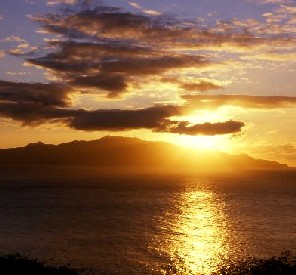
Photographer: Holger Reineccius
St. John seen from St. Philip, Cape Verde
- after famine decimated their island. "These Blacks which came from St. Philip's soon begot in them the Notion of Property; so that he that could kill, catch, or tame most, had most; and soon reduced all the Cattle on the Island to Meum and Tuum [roughly: mine and yours], except the Goats, which, to this Day, remain wild; but are claimed as the Property of the Lord of the Soil, as are all the wild Goats on the Islands."15 So, in addition to being food, the wild goats conferred status in the Cape Verde islands.
They also signified wealth; the bulk of which was shipped back to the native's Portuguese rulers. The governor of St Nicholas [São Nicolau] told Roberts that goat skins were "ordinarily shipp'd off for Portugal, as a Year's Production, without diminishing the Stock, (for that is their Rule, only to kill the Number they think the Stock increases yearly)."16
In fact, before the famine in the island, St Nicholas and two of her uninhabited sister islands, St. Lucia [Santa Luzia] and St. Vincent [São Vicente] sent about 2000 goat skins a year back to Portugal, "all the Skins of He-Goats, the She being the Perquisite of the Steward or Governor, (as they call him) as well as all the Flesh of the Cows and Goats, who has Power to give or sell it, as he pleases."17 Of course, after the famine that all ended "and the Stock of wild Goats was so diminish'd" that the Portuguese didn't even bother to send a ship to collect the tax of skins.
The famine predating Roberts arrival in 1721 seems to have been a cataclysmic event for the goat population in the Cape Verde Islands. He gives a description of several of the Cape Verde islands at the end of his book, often commenting on the situation of the goats on each island. For example, 'Bona' [Boa] Vista used to be the most fertile island "about Thirty or Forty Years ago... But at this Time, there are no Potatoes grow[ing] there, and very little of any thing else.... [Still,] Most of the Inhabitants have Goats;
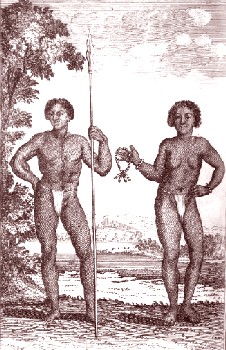
A Man and Woman of the Island of St.
Johns, From
The four years voyages of
Capt. George Roberts, p_422 (1726)
the Milk of which, since the Famine, is a great Part of their Sustenance"18. St. Jago [Santiago] had "good Pasture, so it abounds with Cows and Goats"19.
Although Captain Roberts appeared to have some trade with the Cape Verde Islands, few ships seem to have stopped here according to him, perhaps because the goats were used either to pay the taxes to the King or to feed the islanders.
One last digression on the topic of goats in the Cape Verde Islands and we'll move on to the goats of the Caribbean. Captain Roberts describes something interesting during his time on St. Johns that needs to be recorded somewhere for present readers.
...for they [the natives] never go abroad from their Huts without a Calabash of Water with them, and for their more easy Carriage of that, and their Provisions, when they go a Journey, as also to bring home the Fish or Venison that they catch, they have every one of them a Goatskin, stripped off without cutting the Skin open, something like a Soldier's Knapsack; and the Hide of the Legs being stripped down to the Hoofs, and the Hoofs cut off with the Skin, serves to fling them for their more easy Carriage, which they do by making fast the Feet of one Side together, and putting their Arms through, by which Means they hang over their Backs with little or no Trouble to them, as they are so us'd to them.20
It must have been quite a sight to see the nearly naked natives of St. John running around the island with their goat-arm-strap and skin backpacks!
1 Nathaniel Uring, A history of the voyages and travels of Capt. Nathaniel Uring, p. 90; 2 Uring, p. 90-1; 1 John Covel, "Extracts from the Diaries of Dr. John Covel, 1670-1679," Early Voyages and Travels in the Levant, edited by J. Theodore Bent, p. 120; 4 Captain Charles Johnson, A general history of the pirates, 3rd Edition, p. 188; 5 Johnson, p. 191; 6 Johnson, ibid.; 7 Johnson, p. 197; 8 Woodes Rogers, A Cruising Voyage Round the World, p. 24; 9 George Roberts, The four years voyages of Capt. George Roberts, p. 58; 10 Roberts, p. 195-6; 11 Cape Verde History, capeverdeweb.com, gathered 4/8/13; 12 See for example, Roberts, p. 220 & p. 244; 13 Roberts, p. 264; 14 Roberts, ibid; 15 Roberts, p. 423; 16 Roberts, p. 438; 17 Ibid.; 18 Roberts, p. 393-4; 19 Roberts, p. 404; 20 Roberts, p. 150

